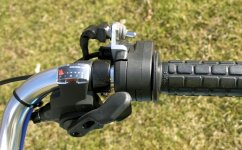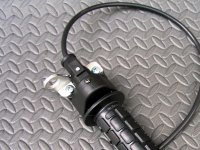Thanks for the link sabongi. Nice to see the e-motocycle folks are thinking about kill switches. I put a few miles in without too much worry -- till I got bit.
Thanks NeilP, I'll take a closer look at the schematic and see if I can defang the CA without throwing it out completely. That sounds great!
-dg, I don't think a bad throttle connection caused this problem. But I'll take another look. Everything was fine after the incident. After my head recovered, anyway ...
It seemed like way more power than just full throttle. Under normal circumstances, from standstill to full speed, my bike is not capable of lifting the front wheel -- even at constant full throttle. But maybe my throttle doesn't give me it's full travel.
It was a lot more power than usual.
I used to wheelie big motorcycles in high school. Sure this bike doesn't weigh much, but it was just a monster that day. Like someone plugged me into a light socket! It happened very fast. I felt like a ski jumper standing way out over the handlebars. Kept the bike from going over backward -- for about a second. It was a situation I knew, so my reflexes were pretty fast. Didn't help. Just put on a show for all the drivers at that busy intersection.
I never had time, or the presence of mind, to grab brakes. I've never used brakes in a wheelie before. :-/ I have it on my list of things to try during future calamities ...

I was too busy hanging on this time.
Better power limiting at the controller would have helped. If I hadn't wheelied the brakes could have gotten things under control. To be useful, an ebike needs to be able to carry a large battery for range -- and not let that power to the motor all at once!
teklektik, The CA is standard setup as it came from ebikes.ca a few years back. The controller was modified by them, but with no special requests. It worked fine last time I tried it.
John in CR, fusing will help some things. But I don't think it's quick enough to have helped in this case. I've been looking at the R/C stuff you mentioned, and am considering rebuilding my battery pack to take advantage of it. (I'm thinking about building another electric skateboard and using R/C parts for that too.)
Separating batteries into 6 or 8 cell modules might have a number of advantages. Even beyond the availability of cheap off-the-shelf chargers, analysers, balancers, LVCs, etc. The ability to compartmentalize failures has an attraction. Lose some cells and still be able to ride home, etc. LIPOs could be divided into separate fire-proof pouches ...
Mahalo for everyone's input. Great stuff! Keep the rubber side down!
Richard



